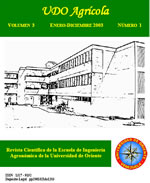
|
Revista Científica UDO Agrícola
Universidad de Oriente Press
ISSN: 1317-9152
Vol. 11, No. 1, 2011, pp. 58-70
|
 Bioline Code: cg11006
Bioline Code: cg11006
Full paper language: English
Document type: Research Article
Document available free of charge
|
|
|
Revista Científica UDO Agrícola, Vol. 11, No. 1, 2011, pp. 58-70
| en |
Biomass production and sugar concentration in two sweet sorghum varieties in the Huasteca Tamaulipeca region
GUTIÉRREZ, Juan VALADEZ; GARCÍA, Julio César; GARCÍA, Francisco ZAVALA & RODRÍGUEZ, Luis Lázaro VALLE
Abstract
Two varieties of sweet sorghum were evaluated in three planting dates with the objective of exploring potential for ethanol
production. The genotypes studied were M81E, variety introduced from the University of Kentucky, USA and Fortuna,
forage variety from Instituto Nacional de Investigaciones Forestales, Agrícolas y Pecuarias (INIFAP), Mexico. The
investigation was conducted in the Southern Region of Tamaulipas. Two variables were mesured: biomass and sugar
concentration (ºBrix). Three population densities (low, intermediate and high) were used. The results showed that the region
presents appropriate conditions for the development of sweet sorghum varieties, where high population densities (200-210
thousand plants ha-1) provide enough biomass profitable in the process of biofuels production. The ºBrix behaved acceptably
falling within the range reported in the literature: 16-19 Brix degrees. Finally, Fortuna showed his best attributes when
planted in October, while M81E did when planted in December.
Keywords
sweet sorghum, varieties, biomass, sugar content, biofuels.
|
| |
| es |
Producción de biomasa y concentración de azúcares de dos variedades de sorgo dulce en la región Huasteca Tamaulipeca
GUTIÉRREZ, Juan VALADEZ; GARCÍA, Julio César; GARCÍA, Francisco ZAVALA & RODRÍGUEZ, Luis Lázaro VALLE
Resumen
Se evaluaron dos variedades de sorgo dulce en tres fechas de siembra, con la finalidad de conocer su potencial como materia
prima para su aprovechamiento en la extracción de etanol. Los genotipos estudiados correspondieron a M81E, variedad
introducida de la Universidad de Kentucky, Estados Unidos y a Fortuna, variedad forrajera del Instituto Nacional de
Investigaciones Forestales, Agrícolas y Pecuarias (INIFAP) liberada en México. La investigación se llevó a cabo en la
Región Sur de Tamaulipas, dentro del Campo Experimental Las Huastecas del INIFAP. Las variables medidas fueron:
biomasa y concentración de azúcares. Éstas se evaluaron en densidades de población baja, intermedia y alta. Los resultados
mostraron que la región presenta condiciones adecuadas para el desarrollo de variedades de sorgo dulce, donde las altas
densidades de población (200-210 mil plantas ha-1) proveen suficiente biomasa aprovechable en el proceso de producción de
biocombustibles (hasta 50 t ha-1). Por otro lado, la concentración de azucares se comportó aceptablemente al ubicarse dentro
de los rangos reportados en la literatura para las variedades de sorgo dulce: 16-19 ºBrix. Finalmente, Fortuna mostró sus
mejores atributos en la siembra de octubre, mientras que M81E lo hizo en la siembra de diciembre.
Palabras-clave
sorgos dulces, variedades, biomasa, concentración de azúcares, biocombustibles.
|
| |
© Copyright 2011 - Revista Científica UDO Agrícola
Alternative site location: http://www.udoagricola.orgfree.com
|
|
